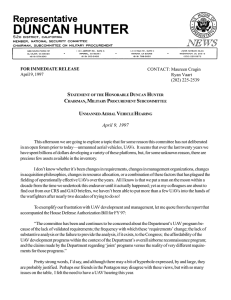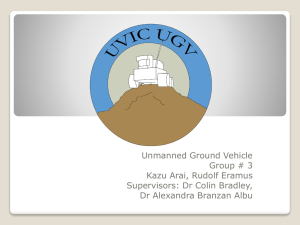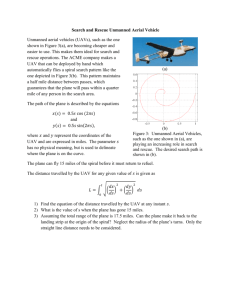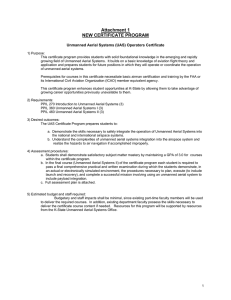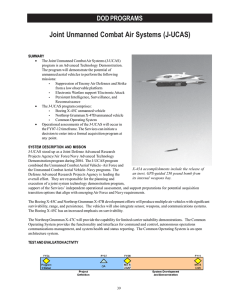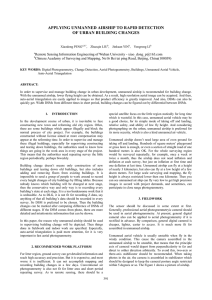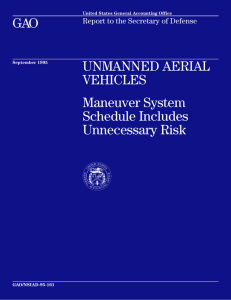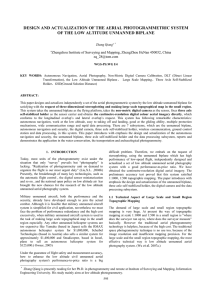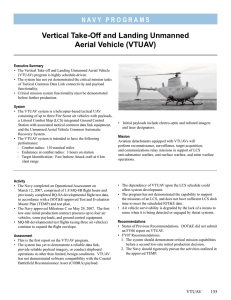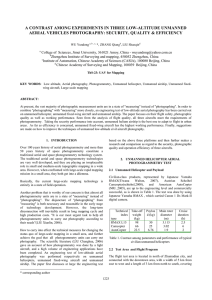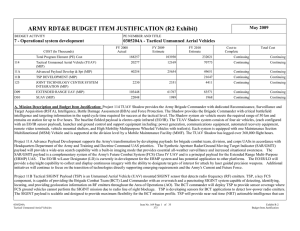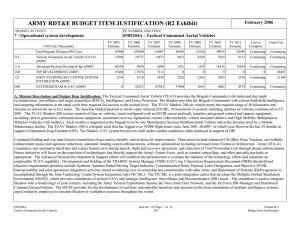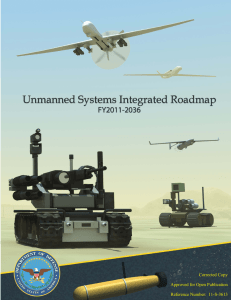HOUSE ARMED SERVICES SUBCOMMITTEE ON TACTICAL AIR AND LAND FORCES CHAIRMAN
advertisement
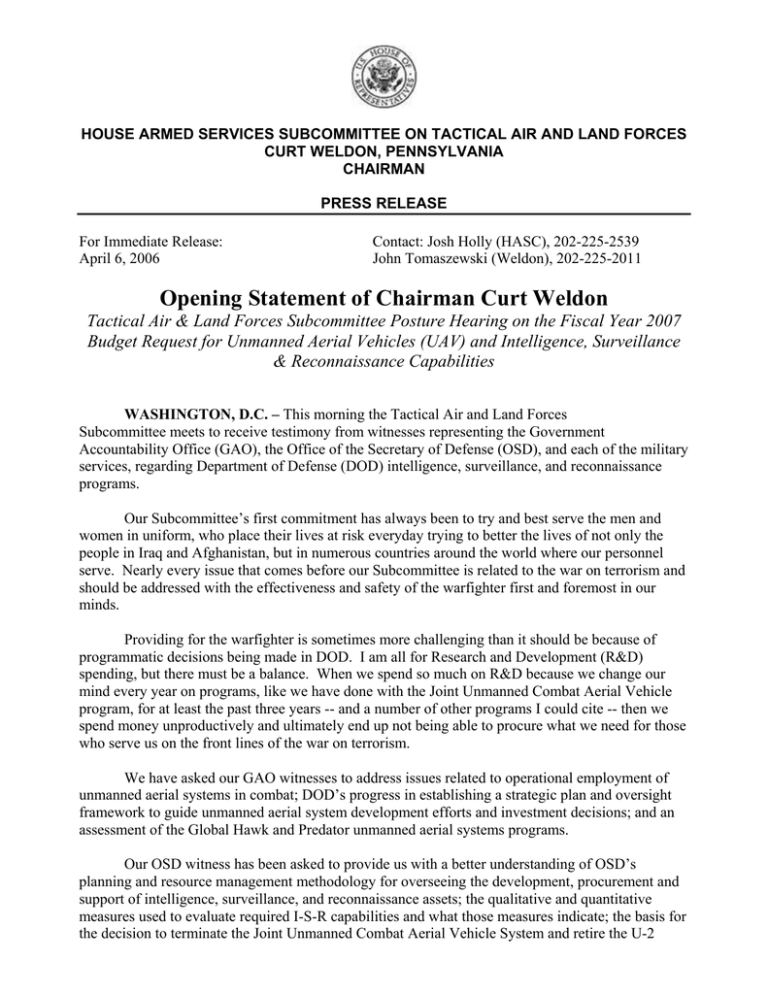
HOUSE ARMED SERVICES SUBCOMMITTEE ON TACTICAL AIR AND LAND FORCES CURT WELDON, PENNSYLVANIA CHAIRMAN PRESS RELEASE For Immediate Release: April 6, 2006 Contact: Josh Holly (HASC), 202-225-2539 John Tomaszewski (Weldon), 202-225-2011 Opening Statement of Chairman Curt Weldon Tactical Air & Land Forces Subcommittee Posture Hearing on the Fiscal Year 2007 Budget Request for Unmanned Aerial Vehicles (UAV) and Intelligence, Surveillance & Reconnaissance Capabilities WASHINGTON, D.C. – This morning the Tactical Air and Land Forces Subcommittee meets to receive testimony from witnesses representing the Government Accountability Office (GAO), the Office of the Secretary of Defense (OSD), and each of the military services, regarding Department of Defense (DOD) intelligence, surveillance, and reconnaissance programs. Our Subcommittee’s first commitment has always been to try and best serve the men and women in uniform, who place their lives at risk everyday trying to better the lives of not only the people in Iraq and Afghanistan, but in numerous countries around the world where our personnel serve. Nearly every issue that comes before our Subcommittee is related to the war on terrorism and should be addressed with the effectiveness and safety of the warfighter first and foremost in our minds. Providing for the warfighter is sometimes more challenging than it should be because of programmatic decisions being made in DOD. I am all for Research and Development (R&D) spending, but there must be a balance. When we spend so much on R&D because we change our mind every year on programs, like we have done with the Joint Unmanned Combat Aerial Vehicle program, for at least the past three years -- and a number of other programs I could cite -- then we spend money unproductively and ultimately end up not being able to procure what we need for those who serve us on the front lines of the war on terrorism. We have asked our GAO witnesses to address issues related to operational employment of unmanned aerial systems in combat; DOD’s progress in establishing a strategic plan and oversight framework to guide unmanned aerial system development efforts and investment decisions; and an assessment of the Global Hawk and Predator unmanned aerial systems programs. Our OSD witness has been asked to provide us with a better understanding of OSD’s planning and resource management methodology for overseeing the development, procurement and support of intelligence, surveillance, and reconnaissance assets; the qualitative and quantitative measures used to evaluate required I-S-R capabilities and what those measures indicate; the basis for the decision to terminate the Joint Unmanned Combat Aerial Vehicle System and retire the U-2 fleet; and the plans to ensure competitiveness and commonality in the development of an unmanned combat aerial vehicle system. The service witnesses have been asked to discuss their respective ISR programs. We continue to have concerns regarding DOD ISR programs. But I do want to recognize the apparent efforts by DOD to address some of the year-after-year problems. Several services and SOCOM have come together to competitively procure the Raven UAV, which improves interoperability and reduces costs through commonality. The services are also beginning to field the tactical common data link to improve interoperability and reduce the bandwidth problem. The Army and Navy are both procuring a common vertical takeoff and landing UAV. And other efforts are ongoing that are encouraging. But as they say, much more remains to be done. As an example, I am not sure why OSD makes the decision to retire the U-2 -- an aircraft with many years of remaining productive life -- and then Strategic Command and the Air Force initiate studies to see if it was a wise decision because of potential signals intelligence shortfalls. Given all the months DOD committed to the Quadrennial Defense Review, it would seem that that would have been a good time to do the studies -- before deleting the funding for U-2s in the fiscal year 07 budget and announcing its early retirement. I am not sure I understand why the Army needs two sets of UAVs, one for the FCS brigade combat teams and another set for the other 80 or so percent of the Army. I am also concerned with the requirement that FCS UAVs be vertical takeoff and landing capable -- whether there is a payload penalty due to payload limitations, and whether there is a loss of stealth due to additional noise attributed to V-TOL engines. We have at least 20 different types of operational unmanned aerial systems, ranging from small unmanned aerial vehicles to the Global Hawk. There are so many unmanned aerial vehicles in various development programs in each of the services and various agencies within the services, that I am confident in saying that all of us here could not collectively name them all. They may be terrific programs, but I don’t think that this is the way we should go about our business. While much has been accomplished, I believe there is reason to be concerned and we can do much better. A whole range of issues exists from OSD oversight; vehicle and data link proliferation, lack of system interoperability, cost growth, inadequate bandwidth availability; shortfalls in program management, to limitations on congressional oversight. ### http://armedservices.house.gov/

